Identifying the Importance of Disaster Resilience Dimensions across Different Countries Using the Delphi Method
Abstract
:1. Introduction
2. Methodology
2.1. General Overview
2.2. Clustering of Countries Based on Sustainable Development
- (1)
- The ratio between the dimensions of sustainable development adopted by the SDG framework: since this framework considers 7 economic goals, 5 social goals, and 5 environmental goals, the relation 7:5:5 was kept when selecting the indicators.
- (2)
- Data availability: indicators were selected in order to have the highest number of countries with no missing values and to limit the need for data imputation.
- (3)
- A connection to the field of disaster risk reduction (DRR): given that DRR is considered to be a cross-cutting issue by the SDG framework, indicators were selected in order to have a larger relevance to this field when possible.
2.3. Resilience Assessment Framework
2.3.1. Dimension 1: Social
- Social fabric—this represents the composition of the population. It can also help to define the potential post-disaster needs. This sub-dimension reflects indicators related to household size, number of female-headed households, number of children per woman, population growth, migration rate, crime rate, social disparity index, quality of life, and educational level.
- Awareness and preparedness—this illustrates all the characteristics specifically related to knowledge about risk, attitude towards risk and disaster preparedness, and risk reduction measures taken at the household/community level. This sub-dimension reflects indicators related to knowledge and perception of risk, risk aversion, and previous disaster-related experience.
- Social capital—this describes all the characteristics that make a community feel like one. This sub-dimension reflects indicators related to attachment to place, sense of community, trust in the community, participation in community activities, common beliefs, and social networks.
- Social capacity—this defines all the qualities and skills that make communities able to withstand adversities, but do not specifically target disaster preparedness. This sub-dimension reflects indicators related to adaptive capacity, problem-solving skills, leadership, capacity building, labor power, and access to resources such as financial resources, tools, materials, and food stocks.
- Social support—this represents a household’s access to support from institutions at different levels (community, municipality, region, and country levels). This sub-dimension reflects indicators related to social security, financial support, counselling services, social assistance and general social services, and entitlement to rights.
2.3.2. Dimension 2: Economic
- Economic level—this represents the amount and source of economic resources on which the population can rely. This sub-dimension reflects indicators related to the level of income, diversification of income, and sources of income.
- Wealth distribution—this describes how wealth is distributed across the population and among genders. This sub-dimension reflects indicators such as the GINI index or the ratio of high income among women/men.
- Pre-disaster financial services—this describes the amount of financial services that are available before a disaster. This sub-dimension reflects indicators such as the number of insurance policies, the number of banks, the number of mortgages, and savings.
- Post-disaster financial services—It describes the amount of financial services that can be provided after the occurrence of a disaster. This sub-dimension reflects indicators related to loans and donations.
- Resources—this defines all the basic resources that are necessary to face a crisis and meet the response and recovery needs. This sub-dimension reflects indicators related to food production, availability of building materials, and manufacturing.
2.3.3. Dimension 3: Environmental
- Natural resources—this represents the amount and diversity of natural resources. This sub-dimension reflects indicators related to land cover classification, available natural resources, and available biomass.
- Land use—this describes how natural resources are exploited and preserved. This sub-dimension reflects indicators related to air quality, water quality, erosion rate, inappropriate land use, deforestation, habitat loss, and biodiversity.
2.3.4. Dimension 4: Habitat
- Settlements—this describes how the population is spatially distributed in the area and the type of entitlement/ownership. This sub-dimension reflects indicators such as population density, percentage of slums/informal settlements, ratio of urban/rural areas, percentage of owners/renters/squatters, and type of ownership.
- Homes—this describes the type and quality of single housing units. This sub-dimension reflects indicators related to housing density, building techniques, year of construction, quality of the housing, and number of mobile homes.
- Regulations and planning—this represents the existence and implementation of regulations connected to the built environment. This sub-dimension reflects indicators related to the presence and implementation of building codes, the availability of housing regeneration plans and urban development plans, and the degree of law enforcement related to the built environment.
2.3.5. Dimension 5: Infrastructure
- Health—this quantifies the capacity of the health infrastructure to treat patients when faced with a disaster. This sub-dimension reflects indicators such as the number of people covered by health insurance and the number of physicians, beds, hospitals, prehospital services, and health centers, as well as their spatial concentration and accessibility.
- WaSH (Water, Sanitation, and Hygiene), electricity, waste treatment—this quantifies the capacity of the water, electrical power, sewage, and waste-treatment infrastructures. This sub-dimension reflects indicators such as the number of power plants, the number of households with electricity and water, the existence of alternative power sources, and the number of people with access to water sanitation and hygiene services.
- Telecommunications—this describes the availability of telecommunication facilities. This sub-dimension reflects indicators such as the number of radio transmitters, the number of households with a fixed telephone, the number of subscriptions to mobile phones, or the number of subscriptions to broadband communications.
- Transportation—this describes the quality and spatial distribution of transportation networks. This sub-dimension reflects indicators such as the capacity of the public transportation network; the number of airports, bus terminals, and ferry facilities; the density of the road network; or the number of paved roads.
- Local services—this quantifies all the local facilities that can be useful in case of an emergency for shelter or to fulfil other primary needs. This sub-dimension reflects indicators such as the number of pharmacies, grocery stores, fire stations, police stations, cars, hotels, or shops.
2.3.6. Dimension 6: Institutional
- Trust in government—this quantifies the population’s level of trust in the local and national governmental institutions in case of a disaster. This sub-dimension reflects indicators such as abstention rate, corruption index, high election turnouts, or the number of past or ongoing conflicts.
- Disaster preparedness and mitigation—this defines the engagement of local and national governmental institutions in the identification of risk, the implementation of mitigation measures, and the ability to produce and engage the population in preparedness campaigns. This sub-dimension reflects indicators such as the capacity for data collection, the availability of risk maps, the capacity for contingency planning, and the number of emergency drills, early warning systems, and disaster risk-related information campaigns.
- Disaster response and recovery—this describes the capacity of local and national governmental institutions to help the population during an emergency in an effective and timely fashion, and to provide the means to support a fast recovery. This sub-dimension reflects indicators such as the type of civil protection systems that are in place, the availability of emergency funds and emergency shelters, and multisector coordination.
2.4. Delphi Process
- It guarantees the anonymity of the experts involved, which, among other advantages, avoids the negative influence that the personality and/or status of the experts could have on certain individual answers.
- It uses repetition to strengthen the results. This means that the experts must be consulted at least twice on the same question/topic, which gives them the ability to reconsider their answers based on the information they are provided with regarding the opinions of the overall experts.
- It includes controlled feedback, which means that the exchange of information between the experts is only carried out by means of a group coordinator.
- It allows the statistical analysis of the experts’ responses. This means the questions need to be formulated in a way that allows the later quantitative and statistical processing of the corresponding responses.
- Do academics, practitioners, and policy makers agree on the proposed conceptual framework for disaster resilience assessment?
- Is the methodology of tailoring the disaster resilience assessment framework to groups of countries useful and viable?
- For each cluster of countries, what is the importance of each dimension of the disaster resilience assessment framework for achieving disaster resilience?
3. Results
3.1. Results Obtained for Each Dimension
3.2. Results Obtained for Each Sub-Dimension
3.2.1. Dimension 1: Social
3.2.2. Dimension 2: Economic
3.2.3. Dimension 3: Environmental
3.2.4. Dimension 4: Habitat
3.2.5. Dimension 5: Infrastructure
3.2.6. Dimension 6: Institutional
4. Discussion
5. Conclusions
- The proposed cluster-specific approach for analyzing and achieving disaster resilience was supported by the fact that the scores and weights of the resilience dimensions and sub-dimensions changed according to the level of development of the countries in each cluster. Therefore, to assess the level of disaster resilience in a given country, the proposed framework should be used, and the resilience dimensions and sub-dimensions weights that were determined for the cluster of that country should be considered.
- Among the six dimensions of resilience that were considered, the Social and the Economic dimensions were those that were given more weight to achieve resilience across the four clusters, while the Habitat and Environmental dimensions were those that were given less weight. The Institutional dimension had the third-highest weight, and was the one with the most stable contribution across the four clusters.
- In clusters involving the least-developed countries, the dimension weights were seen to reflect a large asymmetry in the contribution of each dimension to achieve resilience. This indicated that certain resilience dimensions need to be prioritized for improvements.
- In clusters involving more developed countries, the dimension weights were more evenly distributed. This indicated that each dimension was likely to have achieved a minimum level of contribution to resilience. Still, the characteristics of this minimum level are not understood yet and should be the focus of further research.
- When analyzing the sub-dimensions of the Social dimension, it was seen that, for the cluster involving the least-developed countries (C1), Social Capacity was given a much larger weight than the other sub-dimensions. On the contrary, the weights of the sub-dimensions were more uniform for the other three clusters.
- When analyzing the sub-dimensions of the Economic dimension, the Resources sub-dimension was seen to be the most relevant across the four clusters.
- When analyzing the two sub-dimensions of the Environmental dimension, their weights were seen to be similar across the clusters, and indicated that the way resources are managed is more important than the existence of the actual resources.
- When analyzing the sub-dimensions of the Habitat dimension, the weights obtained for the several sub-dimensions across the individual clusters showed a clear difference between developed and less developed countries. For the latter, Settlement was the most important sub-dimension, while for the former, the Regulations and Planning sub-dimension was the most relevant one. This indicated that in less developed countries (C1 and C2), regulations are usually less enforced and informal settlements are more common, while developed countries (C3 and C4) trust the enforcement of regulations to achieve resilience.
- When analyzing the sub-dimensions of the Infrastructure dimension, WaSH, Electricity and Waste Management, and Health were seen to be the most relevant sub-dimensions across the four clusters, particularly in the least developed countries (C1).
- When analyzing the sub-dimensions of the Institutional dimension, Disaster Response and Recovery was seen to be significantly less relevant for the least developed countries (C1). This indicated that communities might be unable to rely on institutional support in the aftermath of a disaster.
Supplementary Materials
Author Contributions
Funding
Informed Consent Statement
Conflicts of Interest
References
- Norris, F.H.; Stevens, S.P.; Pfefferbaum, B.; Wyche, K.F.; Pfefferbaum, R.L. Community Resilience as a Metaphor, Theory, Set of Capacities, and Strategy for Disaster Readiness. Am. J. Community Psychol. 2008, 41, 127–150. [Google Scholar] [CrossRef]
- Füssel, H.-M. Review and Quantitative Analysis of Indices of Climate Change Exposure, Adaptive Capacity, Sensitivity, and Impacts; The World Bank: Washington, DC, USA, 2010. [Google Scholar]
- Report of the Open-Ended Intergovernmental Expert Working Group on Indicators and Terminology Relating to Disaster Risk Reduction; United Nations General Assembly: New York, NY, USA, 2016.
- Vincent, K. Creating an Index of Social Vulnerability to Climate Change for Africa; Tyndall Centre Working Paper No. 56; University of East Anglia: Norwich, UK, 2004; pp. 1–50. [Google Scholar]
- Fekete, A. Validation of a Social Vulnerability Index in Context to River-Floods in Germany. Nat. Hazards 2009, 9, 393–403. [Google Scholar] [CrossRef] [Green Version]
- Tariq, H. Measuring community disaster resilience at local levels: An adaptable resilience framework. Int. J. Disaster Risk Reduct. 2021, 62, 102358. [Google Scholar] [CrossRef]
- Heijmans, E.P.M. Reaching Resilience: Handbook Resilience 2.0 for Aid Practitioners and Policymakers in Disaster Risk Reduction, Climate Change Adaptation and Poverty Reduction; CARE, Groupe Urgence—Réhabilitation—Développement, Wageningen University: Wageningen, The Netherlands, 2014. [Google Scholar]
- IFRC Framework for Community Resilience; International Federation of Red Cross and Red Crescent Societies: Geneva, Switzerland, 2014.
- Caimi, A.; Adikpon, B.; Adrian, J.C.; Alsayed, A.; Angermaier, A.; Rozado, C.A.; Ashmore, J.; Aurouet, C.; Belinga, C.; Bello, A.; et al. Assessing Local Building Cultures for Resilience & Development: A Practical Guide for Community-Based Assessment; CRAterre: Villefontaine, France, 2015. [Google Scholar]
- Kelman, I. Linking Disaster Risk Reduction, Climate Change, and the Sustainable Development Goals. Disaster Prev. Manag. 2017, 26, 254–258. [Google Scholar] [CrossRef] [Green Version]
- Wamsler, C.; Johannessen, Å. Meeting at the crossroads? Developing national strategies for disaster risk reduction and resilience: Relevance, scope for, and challenges to, integration. Int. J. Disaster Risk Reduct. 2020, 45, 101452. [Google Scholar] [CrossRef]
- Le Tissier, M.; Whyte, H. Why does making connections through resilience indicators matter? In Creating Resilient Futures; Palgrave Macmillan: Cham, Switzerland, 2022; pp. 23–44. [Google Scholar]
- Schipper, E.L.F.; Langston, L. A Comparative Overview of Resilience Measurement Frameworks: Analyzing Indicators and Approaches; Overseas Development Institute: London, UK, 2015. [Google Scholar]
- Michel, J. Beyond Aid: The Integration of Sustainable Development in A Coherent International Agenda; Rowman & Littlefield: Lanham, MD, USA, 2016. [Google Scholar]
- Hallegatte, S.; Vogt-Schilb, A.; Rozenberg, J.; Bangalore, M.; Beaudet, C. From poverty to disaster and back: A review of the literature. Econ. Disasters Clim. Chang. 2020, 4, 223–247. [Google Scholar] [CrossRef] [Green Version]
- Winsemius, H.; Jongman, B.; Veldkamp, T.; Hallegatte, S.; Bangalore, M.; Ward, P. Disaster risk, climate change, and poverty: Assessing the global exposure of poor people to floods and droughts. Environ. Dev. Econ. 2018, 23, 328–348. [Google Scholar] [CrossRef] [Green Version]
- Matthews, E.C.; Friedland, C.J.; Orooji, F. Integrated environmental sustainability and resilience assessment model for coastal flood hazards. J. Build. Eng. 2016, 8, 141–151. [Google Scholar] [CrossRef]
- Marchese, D.; Reynolds, E.; Bates, M.E.; Morgan, H.; Clark, S.S.; Linkov, I. Resilience and sustainability: Similarities and differences in environmental management applications. Sci. Total Environ. 2018, 613, 1275–1283. [Google Scholar] [CrossRef]
- Imperiale, A.J.; Vanclay, F. Using social impact assessment to strengthen community resilience in sustainable rural development in mountain areas. Mt. Res. Dev. 2016, 36, 431–442. [Google Scholar] [CrossRef] [Green Version]
- Constas, M.A.; Mattioli, L.; Russo, L. What does resilience imply for development practice? Tools for more coherent programming and evaluation of resilience. Dev. Policy Rev. 2021, 39, 588–603. [Google Scholar] [CrossRef]
- Levine, S. Assessing Resilience: Why Quantification Misses the Point; Humanitarian Policy Group (ODI) Working Paper; Overseas Development Institute: London, UK, 2014. [Google Scholar]
- Graveline, M.H.; Germain, D. Disaster Risk Resilience: Conceptual Evolution, Key Issues, and Opportunities. Int. J. Disaster Risk Sci. 2022, 13, 330–341. [Google Scholar] [CrossRef]
- Sherrieb, K.; Norris, F.H.; Galea, S. Measuring capacities for community resilience. Soc. Indic. Res. 2010, 99, 227–247. [Google Scholar] [CrossRef]
- Rifat, S.A.A.; Liu, W. Measuring community disaster resilience in the conterminous coastal United States. Int. J. Geo-Inf. 2020, 9, 469. [Google Scholar] [CrossRef]
- Kusumastuti, R.D.; Husodo, Z.A.; Suardi, L.; Danarsari, D.N. Developing a resilience index towards natural disasters in Indonesia. Int. J. Disaster Risk Reduc. 2014, 10, 327–340. [Google Scholar] [CrossRef]
- Shim, J.H.; Kim, C. Measuring resilience to natural hazards: Towards sustainable hazard mitigation. Sustainability 2015, 7, 14153–14185. [Google Scholar] [CrossRef] [Green Version]
- Yoon, D.K.; Kang, J.E.; Brody, S.D. A measurement of community disaster resilience in Korea. J. Environ. Plan. Manag. 2015, 59, 436–460. [Google Scholar] [CrossRef]
- Li, X.; Wang, L.; Liu, S. Geographical analysis of community resilience to seismic hazard in Southwest China. Int. J. Disaster Risk Sci. 2016, 7, 257–276. [Google Scholar] [CrossRef] [Green Version]
- Wu, Y.; Que, W.; Liu, Y.G.; Cao, L.; Liu, S.B.; Zhang, J. Is resilience capacity index of Chinese region performing well? Evidence from 26 provinces. Ecol. Indicat. 2020, 112, 106088. [Google Scholar] [CrossRef]
- Liu, X.; Li, S.; Xu, X.; Luo, J. Integrated natural disasters urban resilience evaluation: The case of China. Nat. Hazards 2021, 107, 2105–2122. [Google Scholar] [CrossRef]
- Ji, T.; Wei, H.H.; Sim, T.; Yang, L.E.; Scheffran, J. Disaggregated validation of disaster-resilience indicators using household survey data: A case study of Hong Kong. Sustain. Cities Soc. 2021, 67, 102726. [Google Scholar] [CrossRef]
- Mavhura, E.; Manyangadze, T.; Aryal, K.R. A composite inherent resilience index for Zimbabwe: An adaptation of the disaster resilience of place model. Int. J. Disaster Risk Reduc. 2021, 57, 102152. [Google Scholar] [CrossRef]
- Parsons, M.; Reeve, I.; McGregor, J.; Hastings, P.; Marshall, G.R.; McNeill, J.; Stayner, R.; Glavac, S. Disaster resilience in Australia: A geographic assessment using an index of coping and adaptive capacity. Int. J. Disaster Risk Reduc. 2021, 62, 102422. [Google Scholar] [CrossRef]
- Marasco, S.; Kammouh, O.; Cimellaro, G.P. Disaster resilience quantifcation of communities: A risk-based approach. Int. J. Disaster Risk Reduc. 2022, 70, 102778. [Google Scholar] [CrossRef]
- Iqbal Khan, M.T.; Anwar, S.; Sarkodie, S.A.; Yaseen, M.R.; Nadeem, A.M.; Ali, Q. Comprehensive disaster resilience index: Pathway towards risk-informed sustainable development. J. Clean. Prod. 2022, 366, 132937. [Google Scholar] [CrossRef]
- Global Resilience Index Initiative. UK Centre for Greening Finance and Investment, Smith School of Enterprise and the Environment, University of Oxford. 2021. Available online: https://www.cgfi.ac.uk/global-resilience-index-initiative/ (accessed on 21 July 2022).
- Brunetta, G.; Caldarice, O. Spatial Resilience in Planning: Meanings, Challenges, and Perspectives for Urban Transition. In Sustainable Cities and Communities; Filho, W.L., Azul, A.M., Brandli, L., Özuyar, P.G., Wall, T., Eds.; Springer: Cham, Switzerland, 2020; pp. 628–640. [Google Scholar]
- Nystrom, M.; Folke, C. Spatial resilience of coral reefs. Ecosystems 2001, 4, 406–417. [Google Scholar] [CrossRef]
- Cumming, G.S. Spatial Resilience in Social-Ecological Systems; Springer: London, UK, 2011. [Google Scholar]
- Cumming, G.S. Spatial resilience: Integrating landscape ecology, resilience, and sustainability. Landsc. Ecol. 2011, 26, 899–909. [Google Scholar] [CrossRef]
- Contreras, D.; Blaschke, T.; Hodgson, M.E. Lack of spatial resilience in a recovery process: Case L’Aquila, Italy. Technol. Forecast. Soc. Chang. 2017, 121, 76–88. [Google Scholar] [CrossRef]
- Shafiei Dastjerdi, M.; Lak, A.; Ghaffari, A.; Sharifi, A. A conceptual framework for resilient place assessment based on spatial resilience approach: An integrative review. Urban Clim. 2021, 36, 100794. [Google Scholar] [CrossRef]
- Brunetta, G.; Salata, S. Mapping Urban Resilience for Spatial Planning—A First Attempt to Measure the Vulnerability of the System. Sustainability 2019, 11, 2331. [Google Scholar] [CrossRef] [Green Version]
- Bănică, A.; Kourtit, K.; Nijkamp, P. Natural disasters as a development opportunity: A spatial economic resilience interpretation. Rev. Reg. Stud. 2020, 40, 223–249. [Google Scholar] [CrossRef]
- Brunetta, G.; Ceravolo, R.; Barbieri, C.A.; Borghini, A.; de Carlo, F.; Mela, A.; Beltramo, S.; Longhi, A.; De Lucia, G.; Ferraris, S.; et al. Territorial resilience: Toward a proactive meaning for spatial planning. Sustainability 2019, 11, 2286. [Google Scholar] [CrossRef] [Green Version]
- Pascariu, G.C.; Banica, A.; Nijkamp, P. A Meta-Overview and Bibliometric Analysis of Resilience in Spatial Planning—The Relevance of Place-Based Approaches. In Applied Spatial Analysis and Policy; Springer: Cham, Switzerland, 2022; pp. 1–31. [Google Scholar] [CrossRef]
- Cutter, S.L.; Barnes, L.; Berry, M.; Burton, C.; Evans, E.; Tate, E.; Webb, J. A place-based model for understanding community resilience to natural disasters. Glob. Environ. Chang. 2008, 18, 598–606. [Google Scholar] [CrossRef]
- Cai, H.; Lam, N.S.; Qiang, Y.; Zou, L.; Correll, R.M.; Mihunov, V.V. A synthesis of disaster resilience measurement methods and indices. I. J. Disaster Risk Reduct. 2018, 31, 844–855. [Google Scholar] [CrossRef]
- Sachs, J.; Schmidt-Traub, G.; Kroll, C.; Lafortune, G.; Fuller, G. SDG Index and Dashboards Report 2018: Global Responsibilities Implementing the Goals; Sustainable Development Solutions Network (SDSN): Paris, France, 2018. [Google Scholar]
- Hsu, C.C.; Sandford, B.A. The Delphi Technique: Making Sense of Consensus. Pract. Assess. Res. Eval. 2007, 12, 1–8. [Google Scholar]
- Handbook on Constructing Composite Indicators: Methodology and User Guide; Joint Research Centre, European Commission: Brussels, Belgium; Organisation for Economic Co-Operation and Development Publishing: Paris, France, 2008.
- Kassambara, A. Practical Guide to Cluster Analysis in R: Unsupervised Machine Learning. Statistical Tools for High-Throughput Data Analysis. STHDA (Statistical Tools for High-Throughput Data Analysis). 2017. Available online: http://www.sthda.com/english/ (accessed on 21 July 2022).
- Gan, G.; Ma, C.; Wu, J. Data Clustering: Theory, Algorithms, and Applications; Society for Industrial and Applied Mathematics: Ottawa, ON, Canada, 2007; Volume 20. [Google Scholar]
- Saja, A.A.; Goonetilleke, A.; Teo, M.; Ziyath, A.M. A critical review of social resilience assessment frameworks in disaster management. Int. J. Disaster Risk Reduct. 2019, 35, 101096. [Google Scholar] [CrossRef]
- Yokohama Strategy and Plan of Action for A Safer World: Guidelines for Natural Disaster Prevention, Preparedness and Mitigation. International Decade for Natural Disaster Reduction 1990–2000. 1994. Available online: http://www.unisdr.org/files/8241_doc6841contenido1.pdf (accessed on 6 January 2022).
- Hyogo Framework for Action 2005–2015: Building the Resilience of Nations and Communities to Disasters. Geneva: United Nations International Strategy for Disaster Reduction. 2005. Available online: https://www.undrr.org/publication/hyogo-framework-action-2005-2015-building-resilience-nations-and-communities-disasters (accessed on 6 January 2022).
- Hoogeveen, J.; Tesliuc, E.; Vakis, V.; Dercon, S. A Guide to the Analysis of Risk, Vulnerability and Vulnerable Groups; Social Protection Unit, Human Development Network, The World Bank: Washington, DC, USA, 2009. [Google Scholar]
- Tapsell, S.M.; Tunstall, S.M.; Green, C.; Fernandez-Bilbao, A. Social Indicator Set; FLOODsite Report T11–07-01; Flood Hazard Research Centre: Enfield, UK, 2005. [Google Scholar]
- Birkmann, J.; Bach, C.; Vollmer, M. Tools for resilience building and adaptive spatial governance. Raumforsch. Raumordn. 2012, 70, 293–308. [Google Scholar] [CrossRef]
- Gaillard, J.C. Vulnerability, capacity and resilience: Perspectives for climate and development policy. J. Int. Dev. 2010, 22, 218–232. [Google Scholar] [CrossRef]
- Hinkel, J. Indicators of vulnerability and adaptive capacity: Towards a clarification of science-policy interface. Glob. Environ. Chang. 2011, 21, 198–208. [Google Scholar] [CrossRef]
- Wenger, C. The oak or the reed: How resilience theories are translated into disaster management policies. Ecol. Soc. 2017, 22, 1–18. [Google Scholar] [CrossRef] [Green Version]
- Tiernan, A.; Drennan, L.; Nalau, J.; Onyango, E.; Morrissey, L.; Mackey, B. A review of themes in disaster resilience literature and international practice since 2012. Policy Des. Pract. 2019, 2, 53–74. [Google Scholar] [CrossRef] [Green Version]
- Hernantes, J.; Maraña, P.; Gimenez, R.; Sarriegi, J.M.; Labaka, L. Towards resilient cities: A maturity model for operationalizing resilience. Cities 2019, 84, 96–103. [Google Scholar] [CrossRef]
- Cutter, S.L.; Burton, C.G.; Emrich, C.T. Disaster resilience indicators for benchmarking baseline conditions. J. Homel. Secur. Emerg. Manag. 2010, 7, 51. [Google Scholar] [CrossRef]
- Cimellaro, G.P.; Reinhorn, A.M.; Bruneau, M. Framework for analytical quantification of disaster resilience. Eng. Struct. 2010, 32, 3639–3649. [Google Scholar] [CrossRef]
- Parsons, M.; Glavac, S.; Hastings, P.; Marshall, G.; McGregor, J.; McNeill, J.; Morley, P.; Reeve, I.; Stayner, R. Top-down assessment of disaster resilience: A conceptual framework using coping and adaptive capacities. Int. J. Disaster Risk Reduct. 2016, 19, 1–11. [Google Scholar] [CrossRef] [Green Version]
- De Silva, S.; Burton, C. Building Resilient Communities: Risk Management and Response to Natural Disasters through Social Funds and Community-Driven Development Operations (English); The World Bank: Washington, DC, USA, 2008. [Google Scholar]
- City Resilience Framework; Rockefeller Foundation; Arup International Development: London, UK, 2014.
- Moraci, F.; Errigo, M.F.; Fazia, C.; Burgio, G.; Foresta, S. Making less vulnerable cities: Resilience as a new paradigm of smart planning. Sustainability 2018, 10, 755. [Google Scholar] [CrossRef] [Green Version]
- Pfefferbaum, R.L.; Pfefferbaum, B.; Van Horn, R.L.; Klomp, R.W.; Norris, F.H.; Reissman, D.B. The Communities Advancing Resilience Toolkit (CART): An Intervention to Build Community Resilience to Disasters. J. Public Health Manag. Pract. 2013, 19, 250–258. [Google Scholar] [CrossRef]
- Raymond, N.; Al Achkar, Z. Data Preparedness: Connecting Data, and Humanitarian Response. In Signal Program Standards and Ethics Series—Issue 1; Harvard University: Cambridge, MA, USA, 2016. [Google Scholar]
- Li, T.; Xie, N.; Zeng, C.; Zhou, W.; Zheng, L.; Jiang, Y.; Yang, Y.; Ha, H.Y.; Xue, W.; Huang, Y.; et al. Data-Driven Techniques in Disaster Information Management. ACM Comput. Surv. 2017, 50, 1–45. [Google Scholar] [CrossRef]
- Sendai Framework for Disaster Risk Reduction 2015–2030; United Nations Office for Disaster Risk Reduction: Geneva, Switzerland, 2015.
- Transforming Our World: The 2030 Agenda for Sustainable Development; Resolution A/RES/70/1; United Nations General Assembly: New York, NY, USA, 2015.
- Bours, D.; McGinn, C.; Pringle, P. Monitoring & Evaluation for Climate Change Adaptation: A Synthesis of Tools, Frameworks and Approaches; SEA Change CoP: Phnom Penh, Cambodia; UKCIP: Oxford, UK, 2013. [Google Scholar]
- Clarke, M.L.; Blanchard, M.K.; Maini, R.; Radu, A.; Eltinay, N.; Zaidi, Z.; Murray, V. Knowing what we know–reflections on the development of technical guidance for loss data for the Sendai framework for disaster risk reduction. PLoS Curr. 2018, 10. [Google Scholar] [CrossRef]
- Berrang-Ford, L.; Biesbroek, R.; Ford, J.D.; Lesnikowski, A.; Tanabe, A.; Wang, F.M.; Chen, C.; Hsu, A.; Hellmann, J.J.; Pringle, P.; et al. Tracking global climate change adaptation among governments. Nat. Clim. Chang. 2019, 9, 440–449. [Google Scholar] [CrossRef]
- Izzo, M.F.; Ciaburri, M.; Tiscini, R. The challenge of sustainable development goal reporting: The first evidence from Italian listed companies. Sustainability 2020, 12, 3494. [Google Scholar] [CrossRef] [Green Version]
- Wu, B.; Tian, F.; Zhang, M.; Zeng, H.; Zeng, Y. Cloud services with big data provide a solution for monitoring and tracking sustainable development goals. Geogr. Sustain. 2020, 1, 25–32. [Google Scholar] [CrossRef]
- Dalkey, N.; Helmer, O. An experimental application of the Delphi method to the use of experts. Manag. Sci. 1963, 9, 458–467. [Google Scholar] [CrossRef]
- Landeta, J. Current validity of the Delphi method in social sciences. Technol. Forecast. Soc. Chang. 2006, 73, 467–482. [Google Scholar]
- Jordan, E.; Javernick-Will, A. Indicators of community recovery: Content analysis and Delphi approach. Nat. Hazards Rev. 2013, 14, 21–28. [Google Scholar] [CrossRef]
- Pei, J.; Liu, W.; Han, L. Research on Evaluation Index System of Chinese City Safety Resilience Based on Delphi Method and Cloud Model. Int. J. Environ. Res. Public Health 2019, 16, 3802. [Google Scholar] [CrossRef] [Green Version]
- Alshehri, S.A.; Rezgui, Y.; Li, H. Delphi-based consensus study into a framework of community resilience to disaster. Nat. Hazards 2015, 75, 2221–2245. [Google Scholar] [CrossRef]
- Delbecq, A.; Van de Ven, A.H.; Gustafson, D.H. Group Techniques for Program Planning: A Guide to Nominal Group and Delphi Processes; Scott Foresman: Glenview, IL, USA, 1975. [Google Scholar]
- Murphy, M.K.; Black, N.A.; Lamping, D.L.; McKee, C.M.; Sanderson, C.F.; Askham, J.; Marteau, T. Consensus development methods, and their use in clinical guideline development. Health Technol. Assess. 1998, 2, 1–88. [Google Scholar] [CrossRef] [Green Version]
- Ludwig, B. Predicting the future: Have you considered using the Delphi methodology? J. Ext. 1997, 35, 1–4. [Google Scholar]
- Dalkey, N. An Experimental Study of Group Opinion: The Delphi Method. Futures 1969, 1, 408–426. [Google Scholar] [CrossRef]
- Cyphert, F.; Grant, W. The Delphi Technique: A Case Study. Phi Delta Kappan 1971, 42, 272–273. [Google Scholar]
- Cerè, G.; Rezgui, Y.; Zhao, W. Urban-scale framework for assessing the resilience of buildings informed by a Delphi expert consultation. Int. J. Disaster Risk Reduct. 2019, 36, 101079. [Google Scholar] [CrossRef]
- Von der Gracht, H.A. Consensus Measurement in Delphi Studies: Review and Implications for Future Quality Assurance. Technol. Forecast. Soc. Chang. 2012, 79, 1525–1536. [Google Scholar] [CrossRef]
- Rayens, M.K.; Hahn, E.J. Building Consensus Using the Policy Delphi Method. Policy Politics Nurs. Pract. 2000, 1, 308–315. [Google Scholar] [CrossRef]
- McKenna, H.P. The Delphi Technique: A Worthwhile Research Approach for Nursing? J. Adv. Nurs. 1994, 19, 1221–1225. [Google Scholar] [CrossRef]
- Williams, P.L.; Webb, C. The Delphi Technique: A Methodological Discussion. J. Adv. Nurs. 1994, 19, 180–186. [Google Scholar] [CrossRef] [PubMed]
- Witkin, B.R.; Altschuld, J.W. Planning and Conducting Needs Assessment: A Practical Guide; Sage Publications, Inc.: Thousand Oaks, CA, USA, 1995. [Google Scholar]
- Burby, R.; Deyle, R.; Godschalk, D.; Olshanky, R. Creating Hazard Resilient Communities through Land-Use Planning. Nat. Hazards Rev. 2000, 1, 99–106. [Google Scholar] [CrossRef] [Green Version]
- Assefa, E.; Hans-Rudolf, B. Indigenous resource management practices in the Gamo Highland of Ethiopia: Challenges and prospects for sustainable resource management. Sustain. Sci. 2017, 12, 695–709. [Google Scholar] [CrossRef]
- Han, J.; Ge, W.; Hei, Z.; Cong, C.; Ma, C.; Xie, M.; Liu, B.; Feng, W.; Wang, F.; Jiao, J. Agricultural land use and management weaken the soil erosion induced by extreme rainstorms. Agric. Ecosyst. Environ. 2020, 301, 107047. [Google Scholar] [CrossRef]
- Martine, G.; Guzman, J.M. Population, poverty, and vulnerability: Mitigating the effects of natural disasters. In ECSP Report 8; Wilson Center: Washington, DC, USA, 2002; pp. 45–68. [Google Scholar]
- Hallegatte, S.; Vogt-Schilb, A.; Bangalore, M.; Rozenberg, J. Unbreakable: Building the Resilience of the Poor in the Face of Natural Disasters; World Bank: Washington, DC, USA, 2017. [Google Scholar]
- Zobel, C.W.; MacKenzie, C.A.; Baghersad, M.; Li, Y. Establishing a frame of reference for measuring disaster resilience. Decis. Support Syst. 2021, 140, 113406. [Google Scholar] [CrossRef]
- De Groeve, T.; Poljansek, K.; Vernaccini, L. Index for Risk Management—INFORM; Report EUR 26528 EN; Joint Research Centre, European Commission: Brussels, Belgium, 2014. [Google Scholar]
- Landeta, J.; Barrutia, J.; Lertxundi, A. Hybrid Delphi: A methodology to facilitate contribution from experts in professional contexts. Technol. Forecast. Soc. Chang. 2011, 78, 1629–1641. [Google Scholar] [CrossRef]
- Bakkensen, L.A.; Fox-Lent, C.; Read, L.K.; Linkov, I. Validating resilience and vulnerability indices in the context of natural disasters. Risk Anal. 2017, 37, 982–1004. [Google Scholar] [CrossRef] [PubMed] [Green Version]
- United Nations Office for Disaster Risk Reduction. Technical Guidance for Monitoring and Reporting on Progress in Achieving the Global Targets of the Sendai Framework for Disaster Risk Reduction. 2018. Available online: https://www.preventionweb.net/publications/view/54970 (accessed on 21 July 2022).
- Feldmeyer, D.; Nowak, W.; Jamshed, A.; Birkmann, J. An open resilience index: Crowdsourced indicators empirically developed from natural hazard and climatic event data. Sci. Total Environ. 2021, 774, 145734. [Google Scholar] [CrossRef]
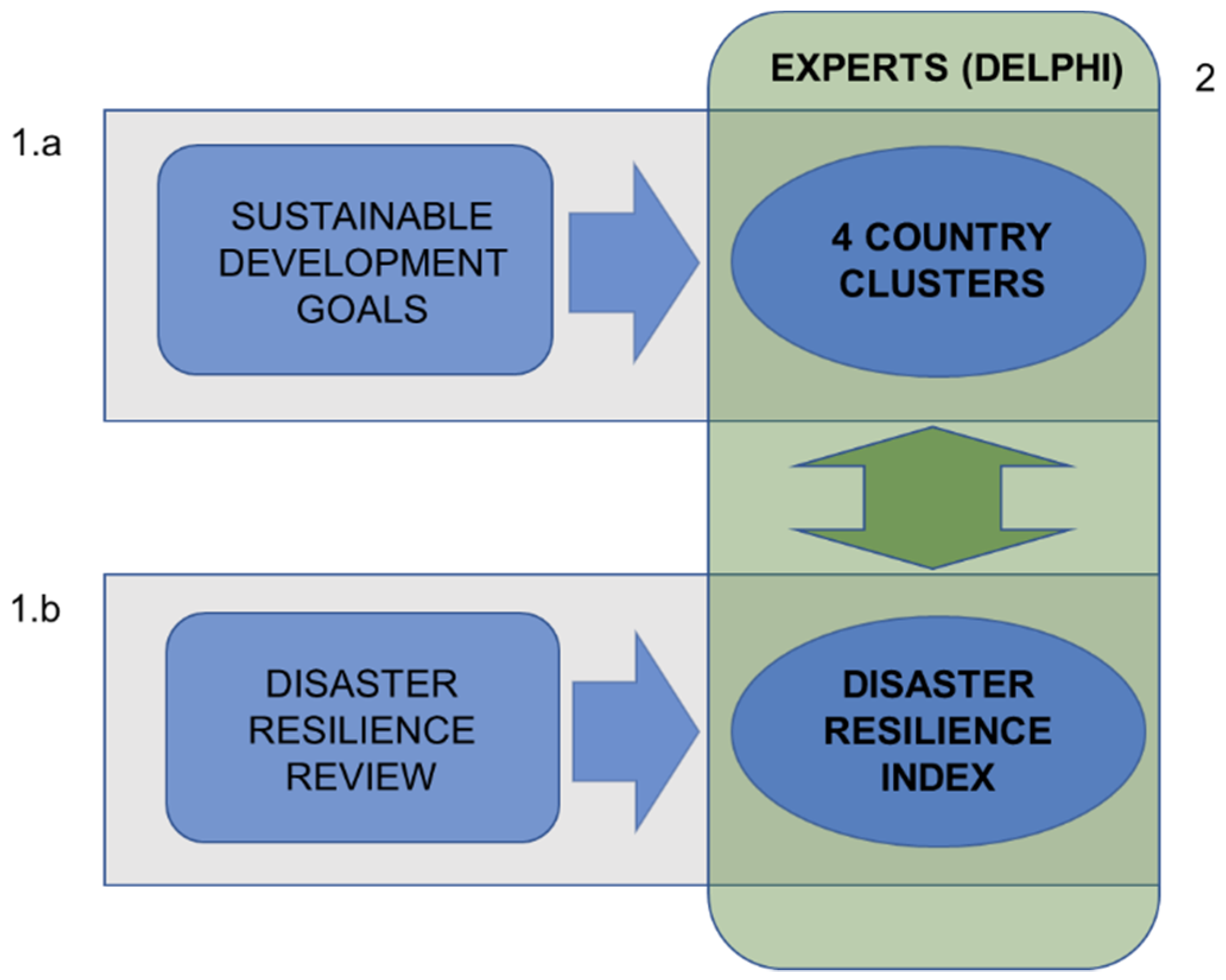
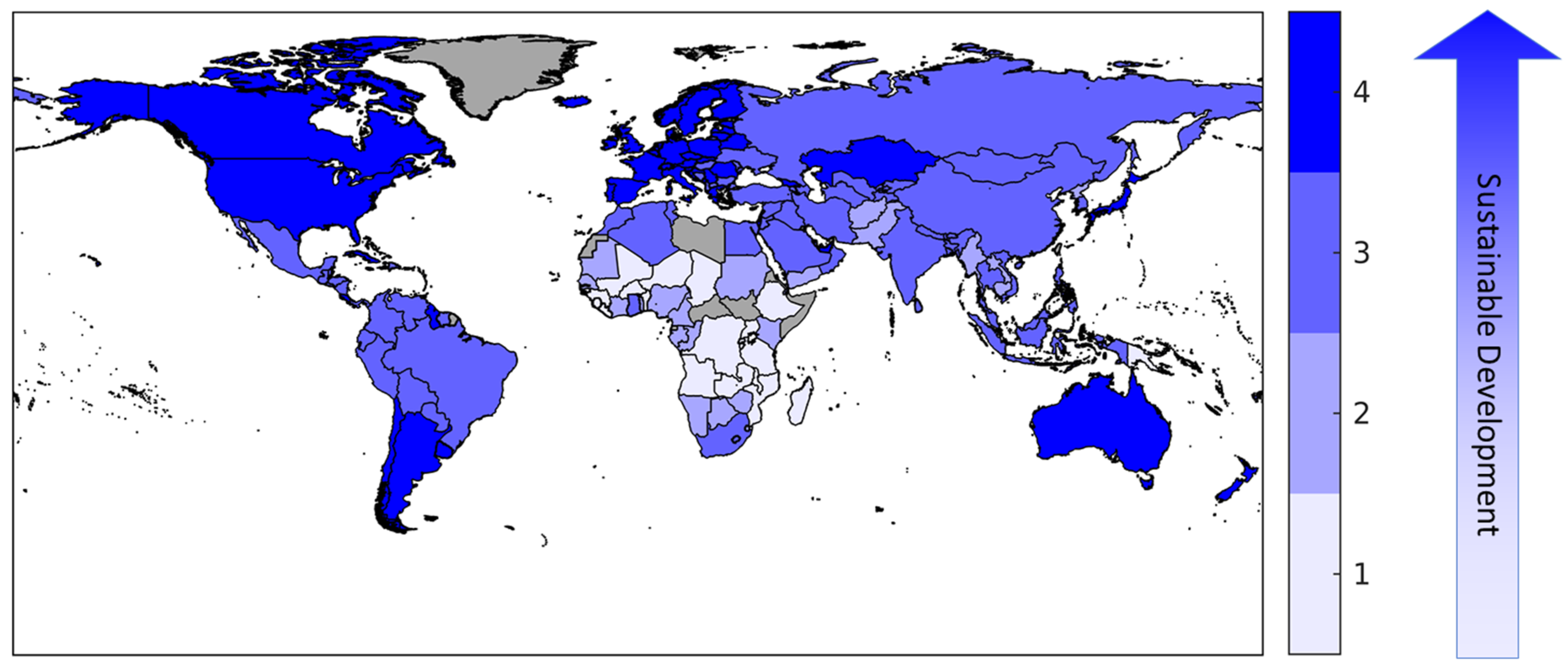
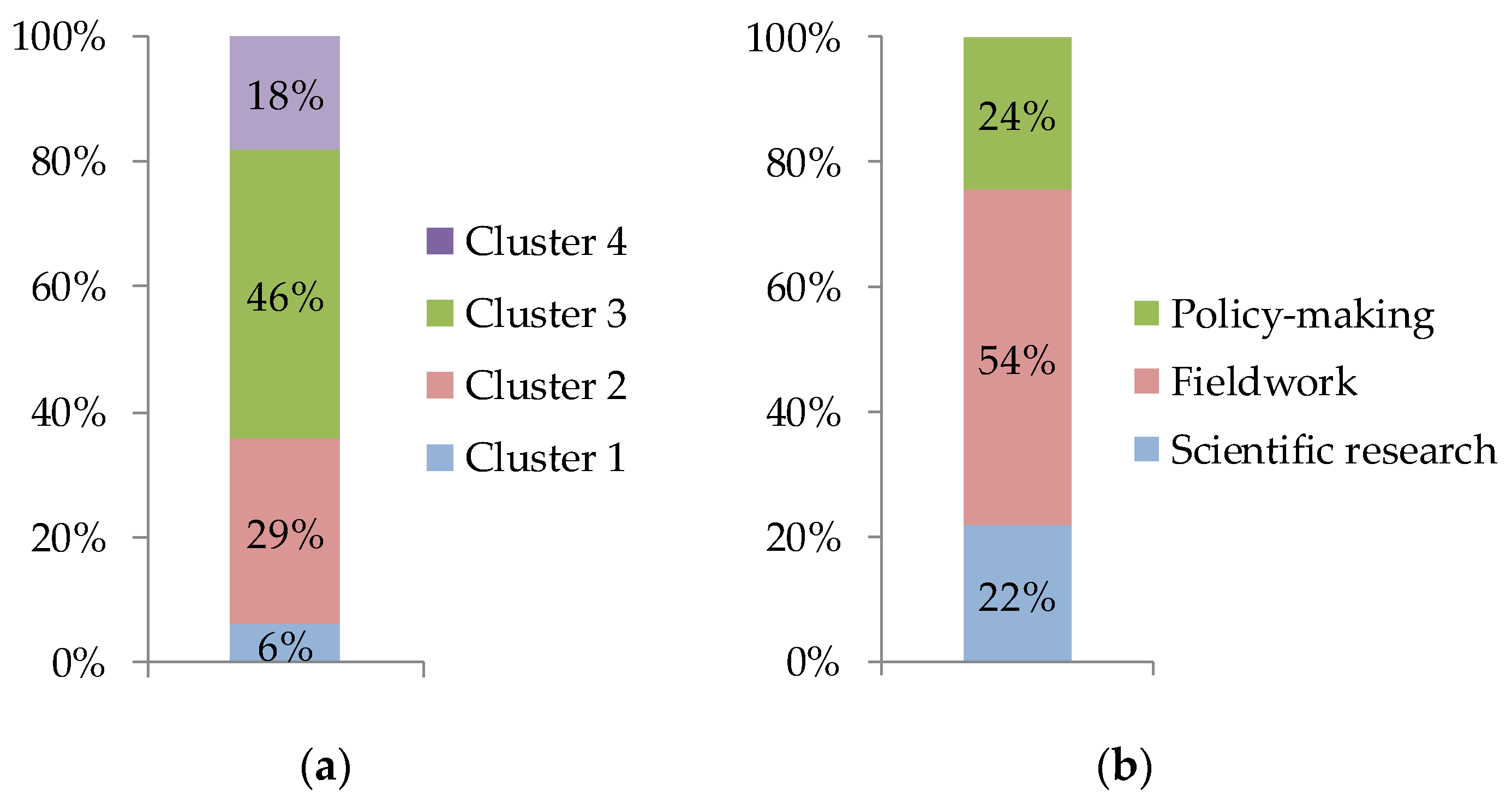
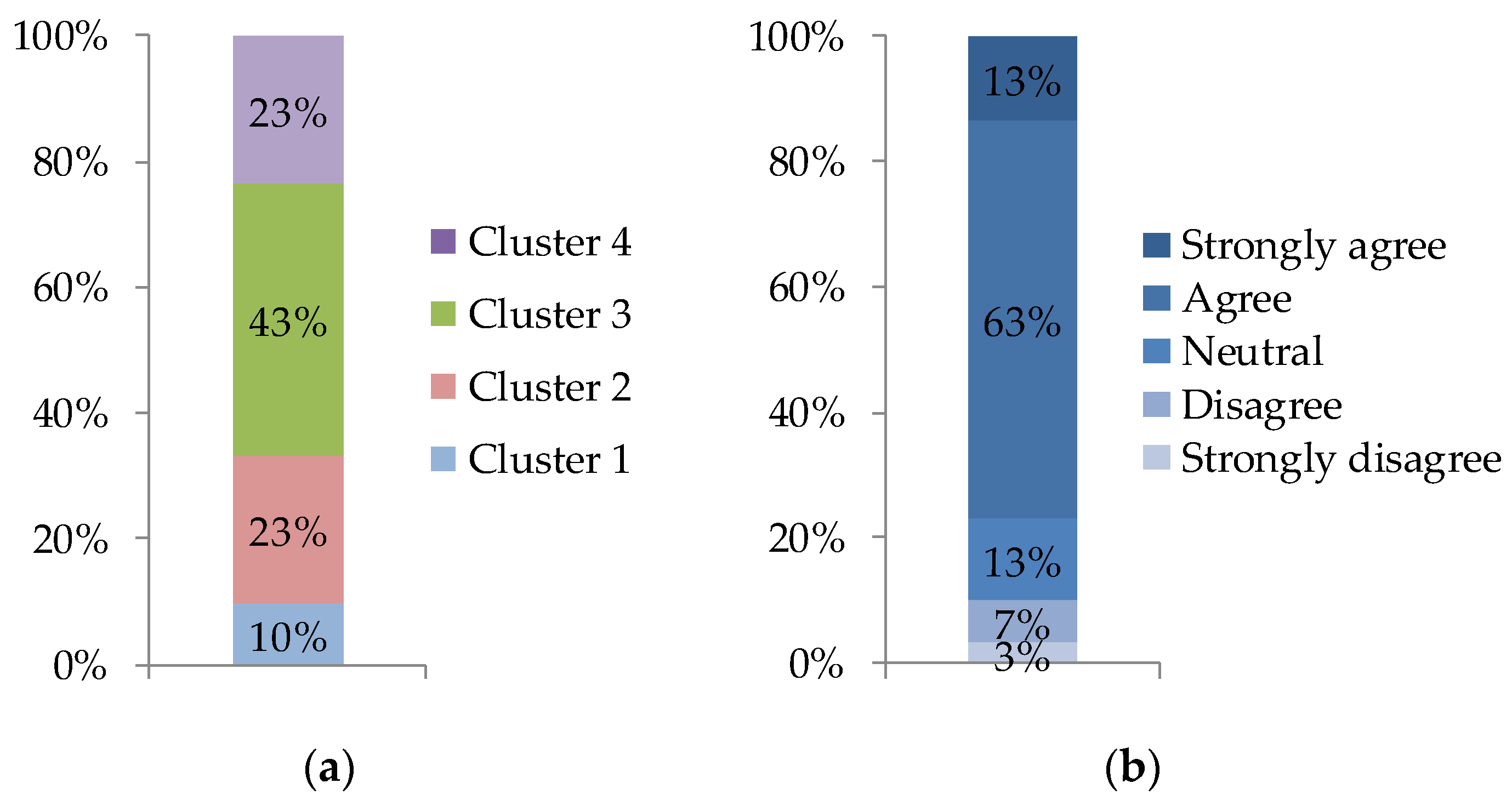
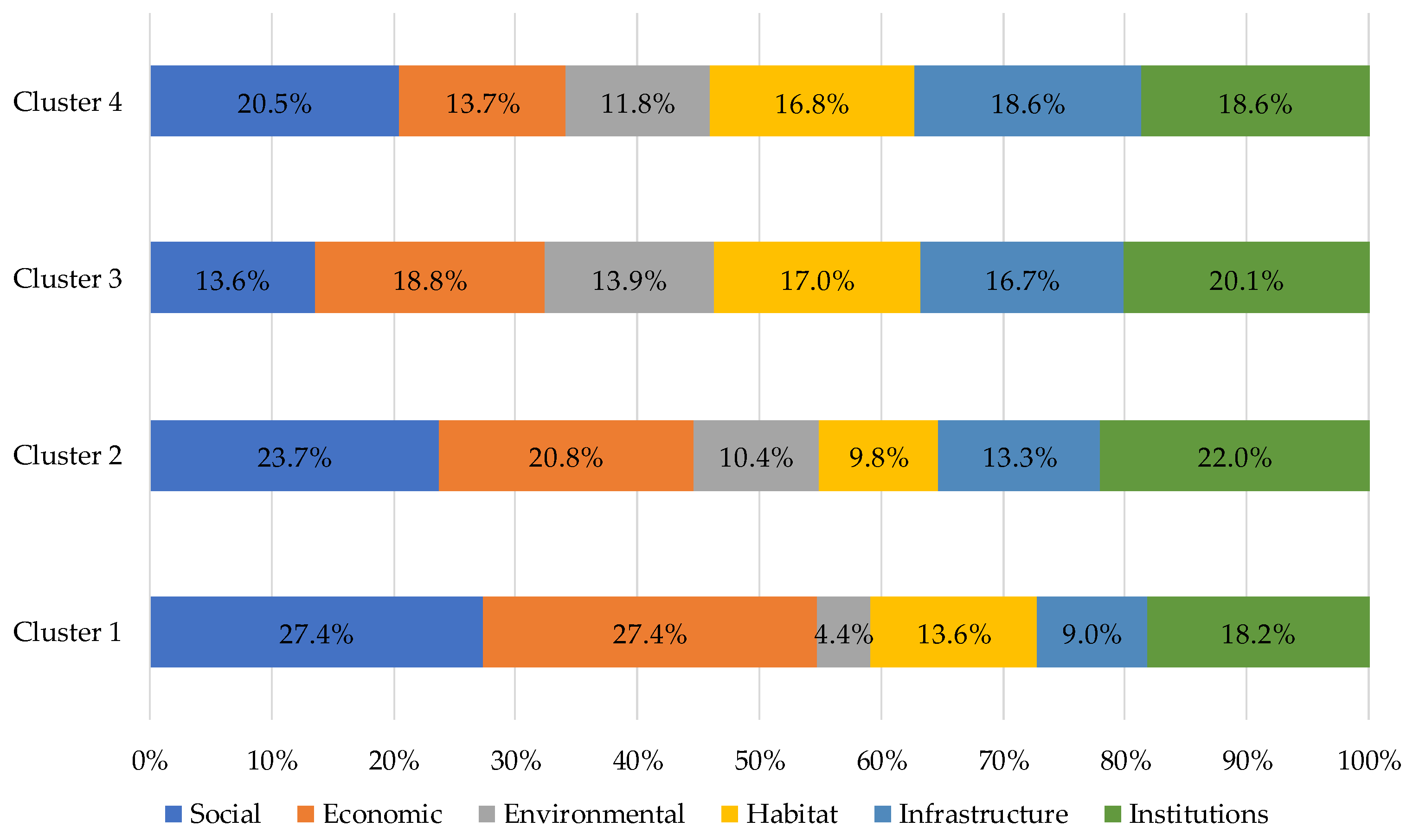



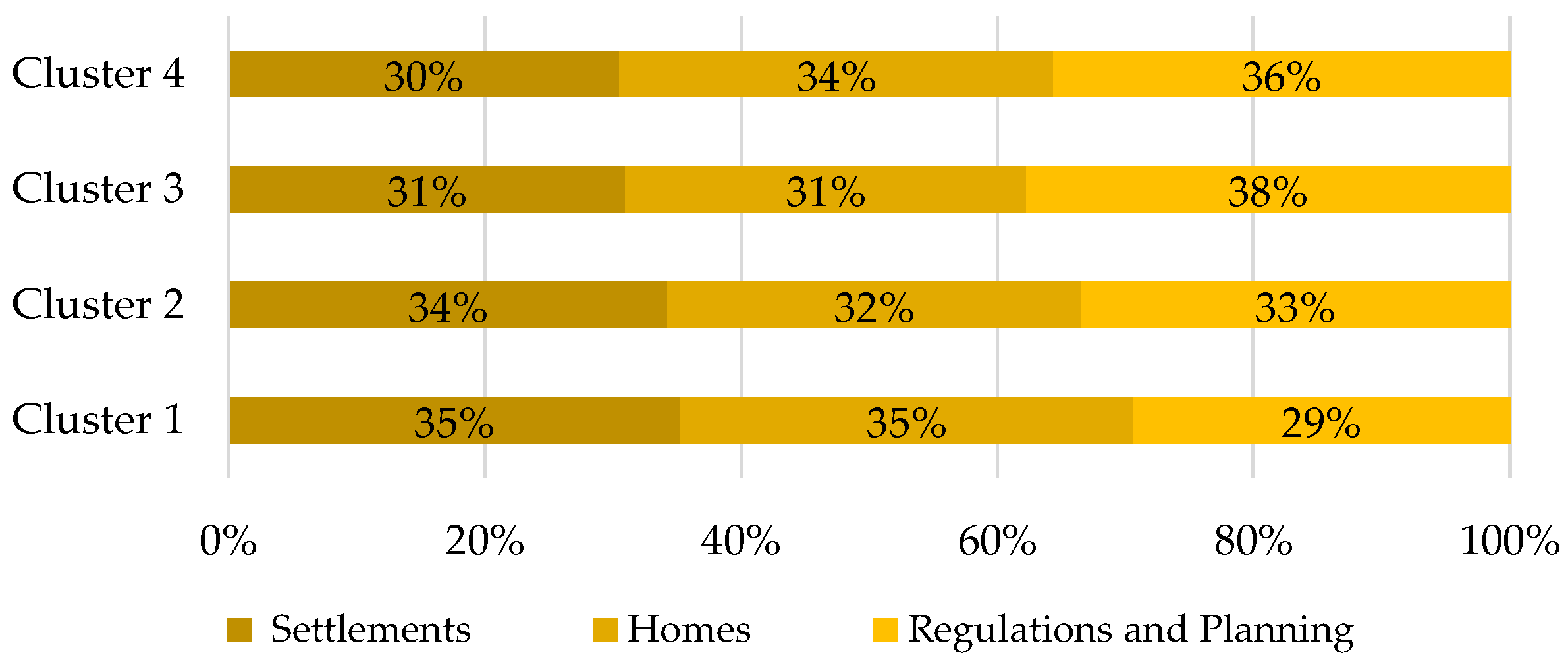
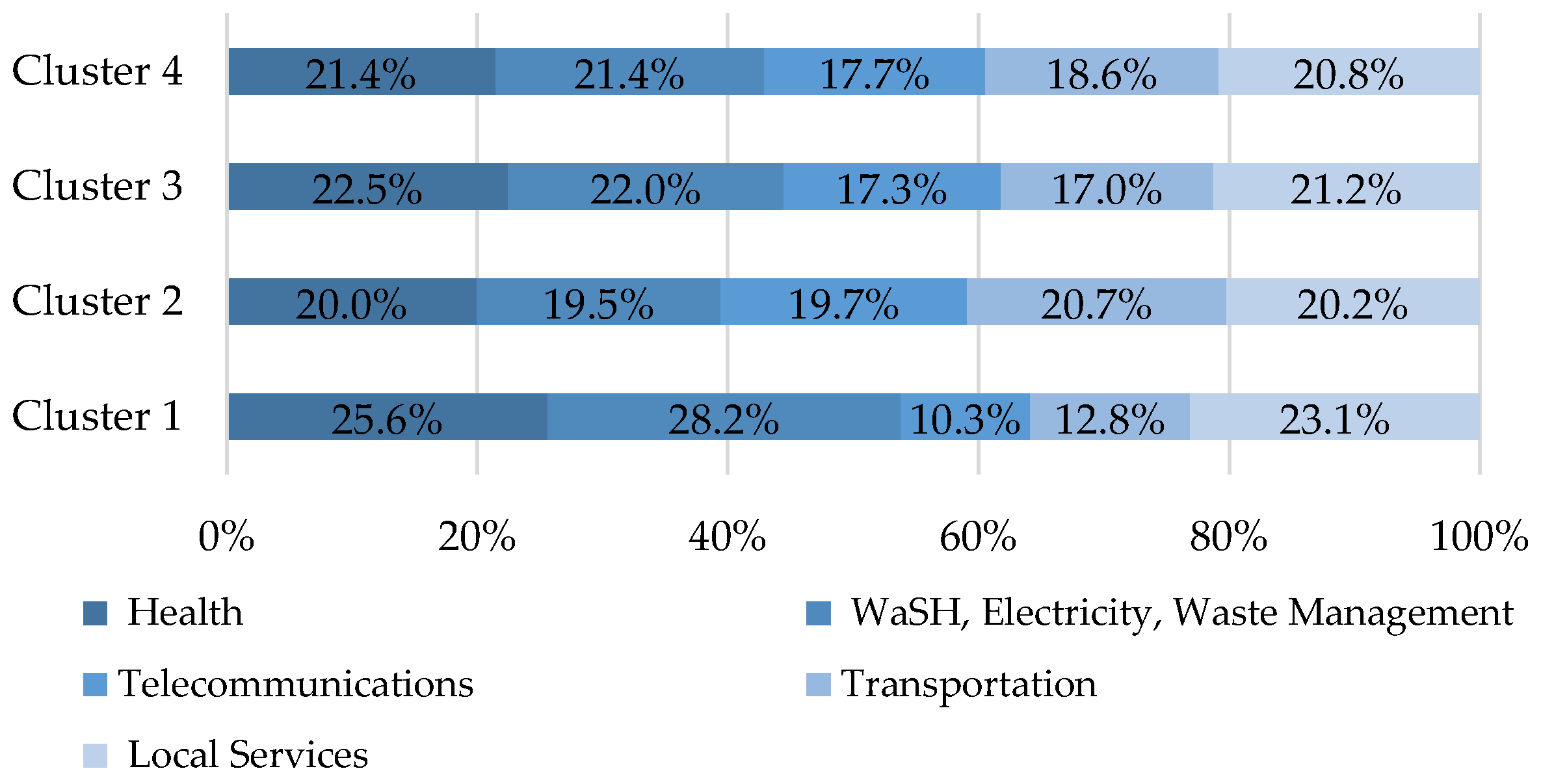
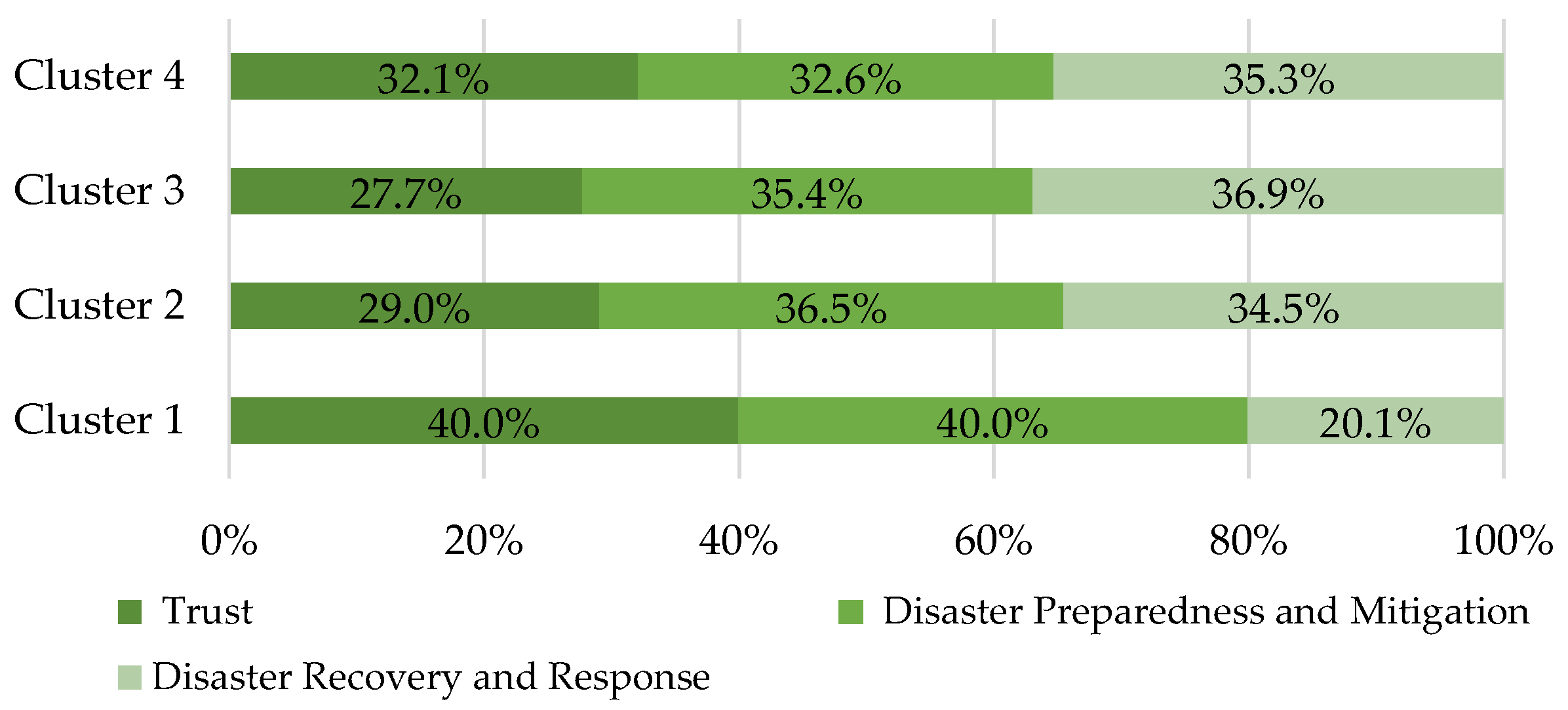
| Dimension | Goal | Indicator (Unit) | Source | Years | |
|---|---|---|---|---|---|
| Economic | G1 | I1 | Proportion of population below USD 1.25 per day—poverty line (%) | World Bank 1 | 2008–2018 |
| Economic | G2 | I2 | Proportion of population below minimum level of dietary energy consumption—prevalence of undernourishment (%) | Food and Agriculture Organization 2 | 2014–2016 |
| Economic | G3 | I3 | Neonatal, infant, and under-5 mortality rate (number of deaths) | World Bank 3 | 2016 |
| Social | G4 | I4 | Percentage of girls and boys who achieve proficiency across a broad range of learning outcomes, including in literacy and in mathematics by end of lower secondary schooling cycle (based on credibly established national benchmarks) (%) | UNESCO 4 | 2009–2017 |
| Social | G5 | I5 | Percentage of seats held by women in national parliament and/or subnational elected office according to their respective share of the population (%) | Inter-Parliamentary Union 5 | 2017 |
| Economic | G6 | I6 | Level of water stress: freshwater withdrawal as a proportion of available freshwater resource (%) | United Nations Statistics Division 6 | 2014 |
| Economic | G7 | I7 | Proportion of population with access to electricity (%) | United Nations Statistics Division 6 | 2014 |
| Economic | G8 | I8 | Growth rate of GDP per person employed (annual % per capita) | United Nations Statistics Division—Analysis of Main Aggregates 7 | 2015 |
| Economic | G9 | I9 | Employment in industry (% of total employment) | International Labour Organization 8 | 2000–2016 |
| Social | G10 | I10 | Gini Index (0 to 100) | World Bank 9 | 2012–2015 |
| Environmental | G11 | I11 | Mean urban air pollution of particulate matter (PM10 and PM2.5) (mcg/m3) | United Nations Statistics Division 6 | 2014 |
| Environmental | G11 (replaces G14) | I12 | Losses from natural disasters, by climate and non-climate-related events (number of lives lost) | EM-DAT: the international disaster database 10 | 2008–2018 |
| Environmental | G12 | I13 | Material footprint per capita (ton per capita) | United Nations Environment Programme 11 | 2010 |
| Environmental | G13 | I14 | CO2 emissions per capita (ton per capita) | World Bank 12 | 2014 |
| Environmental | G15 | I15 | Red List Index (0 to 1) | United Nations Statistics Division 6 | 2017 |
| Social | G16 | I16 | Number of victims of intentional homicide (number per 100,000) | United Nations Statistics Division 6 | 2012–2015 |
| Social | G16 (replaces G17) | I17 | Perception of public sector corruption—Corruption Perception Index (0 to 100) | Transparency International 13 | 2017 |
| Dimension | Sub-Dimension |
|---|---|
| Social (5) | Social fabric |
| Awareness and preparedness | |
| Social capital | |
| Social capacity | |
| Social support | |
| Economic (5) | Economic level |
| Wealth distribution | |
| Pre-disaster financial services | |
| Post-disaster financial services | |
| Resources | |
| Environmental (2) | Natural resources |
| Land use | |
| Habitat (3) | Type of settlement |
| Homes | |
| Regulations and planning | |
| Infrastructure (5) | Health |
| WaSH (Water, Sanitation, and Hygiene), electricity, waste treatment | |
| Telecommunications | |
| Transportation | |
| Local services | |
| Institutional (3) | Trust in government |
| Disaster preparedness and mitigation | |
| Disaster response and recovery |
| Social | Economic | Environm. | Habitat | Infrastruct. | Institutional | |||||||
|---|---|---|---|---|---|---|---|---|---|---|---|---|
| SC | W | SC | W | SC | W | SC | W | SC | W | SC | W | |
| Cluster 1 | 8.2 | 27.4% | 8.2 | 27.4% | 7.2 | 4.4% | 7.6 | 13.6% | 7.4 | 9.0% | 7.8 | 18.2% |
| Cluster 2 | 8.5 | 23.7% | 8.3 | 20.8% | 7.6 | 10.4% | 7.6 | 9.8% | 7.8 | 13.3% | 8.4 | 22.0% |
| Cluster 3 | 8.2 | 13.6% | 8.6 | 18.8% | 8.2 | 13.9% | 8.5 | 17.0% | 8.5 | 16.7% | 8.8 | 20.1% |
| Cluster 4 | 8.9 | 20.5% | 8.3 | 13.7% | 8.1 | 11.8% | 8.6 | 16.8% | 8.8 | 18.6% | 8.8 | 18.6% |
| Cluster 1 | Cluster 2 | Cluster 3 | Cluster 4 | Global | |
|---|---|---|---|---|---|
| Social | 1 | 1 | 6 | 1 | 1 |
| Economic | 1 | 3 | 2 | 5 | 2 |
| Environmental | 6 | 5 | 5 | 6 | 6 |
| Habitat | 4 | 6 | 3 | 4 | 5 |
| Infrastructure | 5 | 4 | 4 | 2 | 4 |
| Institutional | 3 | 2 | 1 | 2 | 3 |
Publisher’s Note: MDPI stays neutral with regard to jurisdictional claims in published maps and institutional affiliations. |
© 2022 by the authors. Licensee MDPI, Basel, Switzerland. This article is an open access article distributed under the terms and conditions of the Creative Commons Attribution (CC BY) license (https://creativecommons.org/licenses/by/4.0/).
Share and Cite
Rodriquez, C.; Mendes, J.M.; Romão, X. Identifying the Importance of Disaster Resilience Dimensions across Different Countries Using the Delphi Method. Sustainability 2022, 14, 9162. https://doi.org/10.3390/su14159162
Rodriquez C, Mendes JM, Romão X. Identifying the Importance of Disaster Resilience Dimensions across Different Countries Using the Delphi Method. Sustainability. 2022; 14(15):9162. https://doi.org/10.3390/su14159162
Chicago/Turabian StyleRodriquez, Carlotta, José Manuel Mendes, and Xavier Romão. 2022. "Identifying the Importance of Disaster Resilience Dimensions across Different Countries Using the Delphi Method" Sustainability 14, no. 15: 9162. https://doi.org/10.3390/su14159162
APA StyleRodriquez, C., Mendes, J. M., & Romão, X. (2022). Identifying the Importance of Disaster Resilience Dimensions across Different Countries Using the Delphi Method. Sustainability, 14(15), 9162. https://doi.org/10.3390/su14159162







